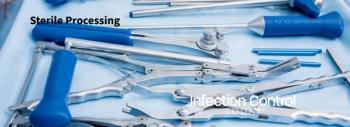
Maintaining Proper Sterile Storage Conditions
By Nancy Chobin, RN, AAS, ACSP, CSPM, CRER
Q: Our facility was cited for improper storage in our sterile storage area. We have wire shelving and due to limited space, and we have to stack our containers and wrapped sets. What are the current standards and how can be best comply with them?
A: Unfortunately, insufficient storage space is almost a universal problem. When sterile processing departments (SPDs) are designed, they are usually designed based on current facility constructions guidelines. Considering most departments do not even get the opportunity for a new area, the existing area can quickly become too small for the processes that change or for storage due to new procedures and equipment needed.
Sterility maintenance is directly affected by packaging materials, storage methods and conditions, handling practices, and methods of distribution. It is essential to ensure that all sterile products, whether sterilized in the facility or purchased from an outside manufacturer, be maintained and stored in such a way that sterility is maintained until a product is used.
The sterile storage area is the area in the facility designed for storage of medical devices and supplies. Most facilities have multiple sterile storage areas. The SPD usually has the largest sterile storage area, but other departments (e.g., OR, nursing units) also have sterile storage areas. Regardless of the location, policies and procedures for sterile storage should be developed according to accepted professional practices to ensure that the function and sterility of medical and surgical devices and supplies are maintained until the time of use. All personnel must conform to the written policies and procedures approved by the facility.
Shelf life is the period of time during which a sterile item is considered safe to use. Shelf life is considered to be event-related, not time-related. That is, while the probability of contamination increases with time, it is more influenced by handling and storage methods. Sterile items that are protected from the environment have been proven to remain sterile indefinitely. However, that is when packages are not handled, they remain in one location. That is not the case in a typical SPD or operating room (OR).
The length of time that a device remains sterile depends on the events that occur that could affect its packaging. Events that can affect sterility maintenance (the length of time that a package will remain sterile) include the following:
Physical damage to the package, such as holes and tears, can be caused by excessive or improper handling, compression of packages on storage shelves (when packages are packed too tightly), stacking packages and instrument sets, crushing packages when personnel are carrying them in their arms, improper packaging (e.g., sharps are able to penetrate the package), and storage cart or shelving conditions. Tears and holes allow airborne bacteria and dust to penetrate the package, compromising the sterility of the device within. Packages should not be stored in a manner that will crush, bend, puncture, or compress them. Storage bins, carts, and shelves should not be overloaded.
Moisture will allow microorganisms from the air and surfaces to wick through packaging materials. Personnel can avoid potential condensation issues by not placing warm packages on a cool surface. In addition, sterile supplies should never be stored near sources of moisture (e.g., sinks, exposed water pipes), nor should they be stored against an outside wall. Excessive humidity levels in the sterile storage area or handling packages too soon after sterilization can also affect sterility.
Soil can also compromise sterility. Any package that is visibly soiled or stained must be considered contaminated, and its contents should be either reprocessed or discarded. Soil from dirty transport carts, soiled hands, and unclean storage bins or shelves can compromise sterility.
Physical damage to packages and exposure of packages to moisture or soil are all affected by storage and handling conditions. That is, how a package is handled and stored determines whether its contents remain sterile. Frequent causes of physical damage include dragging or sliding sterile items on open-wire shelving, stacking heavy wrapped items, placing rigid sterilization containers on top of wrapped packages, storing items in such a way that sharp or heavy instruments can puncture paper–plastic pouches, and bending or compressing packages. Time does not allow contamination to enter a package; contamination enters when a package is wet, torn, dropped, crushed, otherwise mishandled, or opened.
The major challenge to healthcare professionals is how to determine if the sterility of a package has been compromised when there is no obvious damage. For example, a paper–plastic pouch might not have any visible holes or tears in the packaging material, but there might be numerous creases in the paper side of the package. Is there sufficient damage to the package to permit contamination? That is the question. It would be wonderful if single-use-packaging manufacturers could develop a material that changes color if the integrity of the packaging is compromised.
A very important consideration is the shelf-life data provided by the packaging manufacturer. Most experts agree that the expiration dating policy is time-consuming and can be wasteful, especially for items that are seldom used. In general, there is a different philosophy today: Compliance with manufacturers’ instructions is paramount. The FDA requires all manufacturers of packaging materials, including sterilization wrappers, paper–plastic pouches, and rigid sterilization containers, to include a shelf-life statement in their IFU and to provide shelf-life information to end users; this information must be based on performance testing, including shelf-life simulation studies. It is important to obtain this information and to discuss expiration dating with the risk management and infection prevention departments. Shelf-life data and packaging manufacturers’ instructions should be the basis for whether the healthcare facility uses expiration dating of items sterilized in SPD. In addition, the packaging manufacturer should provide guidance on stacking. This guidance should be followed.
To prevent the contamination of sterile items, procedures for routine daily cleaning of the sterile storage area must be clearly defined. Routine daily cleaning includes wet mopping or vacuuming of the floors with a germicidal solution. The mops and mop buckets used for this purpose must be clean at the outset.
Procedures for the routine cleaning of walls and ceiling vents and for periodic stripping and waxing of floors must also be developed; such cleaning might be needed as frequently as every month. The managers of SPD and Environmental Services must work together to develop policies and procedures for these cleaning tasks, and all staff in both departments must be qualified through training to perform the procedures. All staff performing cleaning procedures must wear appropriate attire while in SPD.
The routine cleaning of storage bins and shelves is the responsibility of SPD personnel. A policy should be developed for frequency of cleaning, and a sign-off sheet should be used to indicate when the cleaning was last done. The appropriate frequency of cleaning depends on a number of factors, including the amount of traffic in the area, the ventilation system, and the packaging system used. Dust is a major enemy of sterile packages because many microorganisms can live in dust and dust can act as a carrier for microorganisms.
Whether the facility uses a dating shelf-life system or an event-related shelf-life system, the important thing is to routinely check packages and storage conditions. These checks should be performed on a regular basis and documented.
All sterile items should be handled as little as possible and stored in an area where the environment is suitable and monitored. All items should be rotated and their frequency of use evaluated. Items that are rarely used should be removed from inventory.
Shelf life is not just a matter of sterility maintenance. Many products from outside manufacturers carry expiration dates that relate to product and packaging degradation, not to product sterility per se. It is important that sterile items be properly stored so that the packaging is not compromised. Shelf-life requirements always apply to supplies received from outside vendors as well as to those processed in the SPD.
The sterile storage standards have traditionally provided guidance such as keeping storage at least 18 inches from a sprinkler head (fire code), 8 inches to 10 inches off the floor (to facilitate cleaning and prevent splashing of items when floors are cleaned) and 2 inches from an outside wall (if applicable).
Either closed or open wire shelving can be used however wire shelving may require more attention for cleaning. In order for items to be protected, there should be sufficient space allocated for storage of sterile items. When items are “crushed” into a storage bin, it can damage the packaging. In addition, the instrument may be subjected to damage.
In summary, sterile processing personnel spend a great deal of time processing devices. It is their responsibility of all personnel handling sterile packages to ensure that products labeled as sterile, remain sterile until used. Always follow the packaging manufacturer’s instructions for use. Comply with all standards for storage of sterile product. Review the inventory in your sterile storage area and see if there are unused items or too many sets (due to changes in practices) that can be removed from service. Meet with the infection prevention and materials management departments to see how the storage area can be improved to increase storage capability using a different type of shelving (i.e., high-density shelving). Every effort should be made to correct the deficiencies to ensure the safety of devices being distributed from your department.
Nancy Chobin, RN, AAS, ACSP, CSPM, CRER, is a sterile processing consultant and educator.
References:
ANSI/AAMI: ST79:2017. Comprehensive Guide to Steam Sterilization and Sterility Assurance in Healthcare Facilities.
Basics of Sterile Processing 6th Edition. Sterile Processing University, LLC. Lebanon, N.J.
Newsletter
Stay prepared and protected with Infection Control Today's newsletter, delivering essential updates, best practices, and expert insights for infection preventionists.





